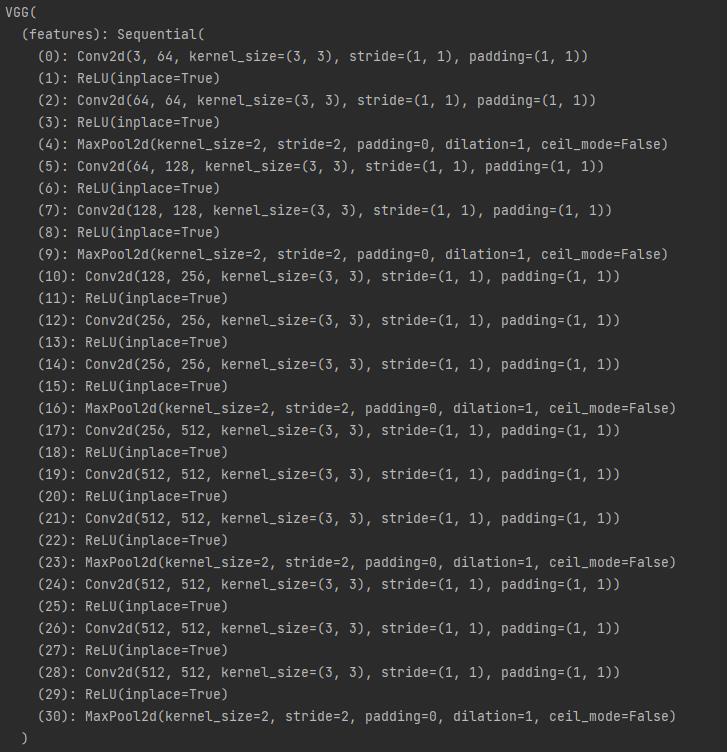Pytorch 网络模型的保存与读取
Posted ʚVVcatɞ
tags:
篇首语:本文由小常识网(cha138.com)小编为大家整理,主要介绍了Pytorch 网络模型的保存与读取相关的知识,希望对你有一定的参考价值。
保存方式一:
例如:对 vgg16 网络模型进行保存,模型如下

模型保存使用 torch.save() 方法
torch.save(模型, "文件名.h5") # 保存 模型结构 + 模型参数
使用方式如下:
import torch
import torchvision
vgg16 = torchvision.models.vgg16(pretrained=False) # 加载vgg16网络模型
# 保存方式1
torch.save(vgg16, "vgg16_method.pth") # 保存为 vgg16_method.pth 文件
加载保存后的模型文件
import torch
model = torch.load("vgg16_method.pth")
print(model)
保存方式二:
import torch
import torchvision
vgg16 = torchvision.models.vgg16(pretrained=False) # 加载vgg16网络模型
# 保存模型的参数
torch.save(vgg16.state_dict(), "vgg16_method.pth") # 把模型的参数 保存成字典
加载保存后的模型文件
import torch
model = torch.load("vgg16_method.pth") # 使用 torch.load 加载 模型文件,得到模型的参数
print(model)

使用以下方法得到完整的网络模型
import torch
import torchvision
vgg16 = torchvision.models.vgg16(pretrained=False)
vgg16.load_state_dict(torch.load("vgg16_method.pth"))
print(vgg16)
保存自定义模型:
下面是自定义了一个 VVcatModel 模型进行保存。
import torch
from torch import nn
class VVcatModel(nn.Module):
def __init__(self):
super().__init__()
self.conv1 = nn.Conv2d(3, 64, kernel_size=3)
def forward(self, x):
x = self.conv1(x)
return x
vvcat = VVcatModel() # 实例化模型
torch.save(vvcat, "vgg16_method.pth")
加载自定义模型
import torch
from torch import nn
class VVcatModel(nn.Module):
def __init__(self):
super().__init__()
self.conv1 = nn.Conv2d(3, 64, kernel_size=3)
def forward(self, x):
x = self.conv1(x)
return x
# 此处不需要实例化模型
model = torch.load("vgg16_method.pth")
print(model)
注:自定义保存模型与加载自定义模型区别在于,加载模型时,不需要实例化模型。

注意:
如果使用GPU去训练生成的网络模型文件,在加载时可能出现以下错误
RuntimeError: Input type (torch.FloatTensor) and weight type (torch.cuda.FloatTensor) should be the same or input should be a MKLDNN tensor and weight is a dense tensor

当使用GPU去训练生成的网络模型文件,在加载时使用的是CPU去加载,所以,在加载该网络文件时,需要指定CPU去加载该文件, map_location=torch.device(‘cpu’),添加如下:
model = torch.load("./vgg16_method.pth", map_location=torch.device('cpu'))
以上是关于Pytorch 网络模型的保存与读取的主要内容,如果未能解决你的问题,请参考以下文章